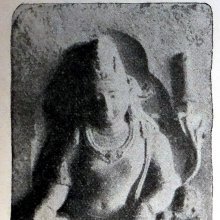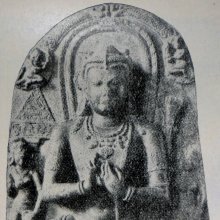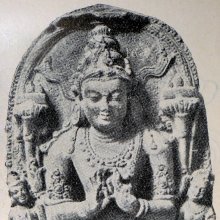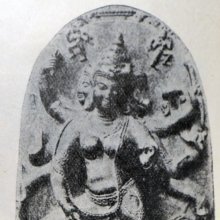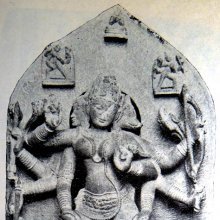Sentiment: 3 definitions
Introduction:
Sentiment means something in Hinduism, Sanskrit. If you want to know the exact meaning, history, etymology or English translation of this term then check out the descriptions on this page. Add your comment or reference to a book if you want to contribute to this summary article.
Images (photo gallery)
(+5 more images available)
In Hinduism
Gitashastra (science of music)
Source: Shodhganga: Elements of Art and Architecture in the Trtiyakhanda of the Visnudharmottarapurana (gita)The Sentiment (in Indian classical Music) is denoted by the Sanskrit term Rasa, and they have an inherent relationship with the svaras (“musical notes”). There are nine kinds of sentiments. In the Nāṭyaśāstra some particular svaras are determined for the delineation of some specific sentiments. In the Viṣṇudharmottarapurāṇa, the laya i.e., the tempo of Music is also determined according to the sentiments.
Gitashastra (गीतशास्त्र, gītaśāstra) refers to the ancient Indian science of Music (gita or samgita), which is traditionally divided in Vocal music, Instrumental music and Dance (under the jurisdiction of music). The different elements and technical terms are explained in a wide range of (often Sanskrit) literature.
Natyashastra (theatrics and dramaturgy)
Source: Shodhganga: Elements of Art and Architecture in the Trtiyakhanda of the Visnudharmottarapurana (natya)The Sentiment (in Sanskrit: Rasa) is a very important component in poetry. Drama belongs to dṛśyakāvya variety and for this reason it can be said that rasa i.e., sentiment is the soul of Drama too. The primary meaning of rasa refers to taste or to savour or to relish, but metaphorically it means the emotional experience of beauty in poetry.
The Viṣṇudharmottarapurāṇa accepts nine rasas or “sentiments in Drama”. These are—
- Erotic (= śṛṅgāra),
- Humour (= hāsya),
- Pathos (= karuṇa),
- Furious (= raudra),
- Heroic (= vīra),
- Terrible (= bhayānaka),
- Wonder (= adbhuta),
- Odious (= bībhatsa) and
- Quietism (= śānta).

Natyashastra (नाट्यशास्त्र, nāṭyaśāstra) refers to both the ancient Indian tradition (shastra) of performing arts, (natya—theatrics, drama, dance, music), as well as the name of a Sanskrit work dealing with these subjects. It also teaches the rules for composing Dramatic plays (nataka), construction and performance of Theater, and Poetic works (kavya).
Kavyashastra (science of poetry)
Source: Shodhganga: Elements of Art and Architecture in the Trtiyakhanda of the Visnudharmottarapurana (kavya)The Sentiment (Rasa) is “the soul of a kāvya or poetry”.—The Sentiment is a very important component in poetry. Through the delineation of different sentiments different way, the connoisseurs can relish the taste of a poetic piece. The primary meaning of rasa refers to taste or to savour or to relish, but metaphorically it means the emotional experience of beauty in poetry. The sentiment is that which touches our heart and fills it with a great sensation, after reading or hearing a piece of poetry or viewing a performing art. But the point to be noted here is that only suggestive type of literary piece has the capacity to reflect the sentiment or rasa, as rasa itself is always suggestive.

Kavyashastra (काव्यशास्त्र, kāvyaśāstra) refers to the ancient Indian tradition of poetry (kavya). Canonical literature (shastra) of the includes encyclopedic manuals dealing with prosody, rhetoric and various other guidelines serving to teach the poet how to compose literature.
See also (Relevant definitions)
Full-text (+870): Karuna, Bibhatsa, Adbhutarasa, Rasa, Shringara, Erotic, Abhinaya, Bhayanaka, Hasyarasa, Samcarin, Vira, Rasabhasa, Karunarasa, Adbhuta, Virarasa, Odious, Humour, Pathos, Heroic, Shringararasa.
Relevant text
Search found 163 books and stories containing Sentiment; (plurals include: Sentiments). You can also click to the full overview containing English textual excerpts. Below are direct links for the most relevant articles:
Dasarupaka (critical study) (by Anuru Ranjan Mishra)
Part 9 - Sentiments (rasa) used in a Vyāyoga < [Chapter 5 - Vyāyoga (critical study)]
Part 9 - Sentiments (rasa) used in a Vīthī < [Chapter 7 - Vīthī (critical study)]
Similarity between the Daśarūpaka and the Nāṭyaśāstra < [Introduction]
Natyashastra (English) (by Bharata-muni)
Chapter VI - Sentiments (rasa)
Chapter VIII - Gestures of Minor Limbs (upāṅga)
The Matsya Purana (critical study) (by Kushal Kalita)
Part 3 - Rasa (sentiment) in the Matsyapurāṇa < [Chapter 2 - Literary aspect of the Matsyapurāṇa]
Literary Aspect (Introduction) < [Chapter 2 - Literary aspect of the Matsyapurāṇa]
Vishnudharmottara Purana (Art and Architecture) (by Bhagyashree Sarma)
7(h): Connection of Sentiments with the Paintings < [Chapter 5 - Painting and Image Making]
1.3. Elements of Drama (h): Sentiment (Rasa) < [Chapter 3 - Drama and Dance]
1.4. Types of Drama < [Chapter 3 - Drama and Dance]
The backdrop of the Srikanthacarita and the Mankhakosa (by Dhrubajit Sarma)
Part 2 - Rasa or the sentiment < [Chapter III - Literary Assessment Of The Śrīkaṇṭhacarita]
Part 2a - Rasa (1): Vīra or the sentiment of heroism < [Chapter III - Literary Assessment Of The Śrīkaṇṭhacarita]
Part 2g - Rasa (7): Bībhatsa or the sentiment of disgust < [Chapter III - Literary Assessment Of The Śrīkaṇṭhacarita]
Dramaturgy in the Venisamhara (by Debi Prasad Namasudra)
Vṛtti (mode of conduct)—Introduction < [Chapter 4 - Dramaturgy in Veṇīsaṃhāra]
Abhyāsa: Psuedo-Suggestion < [Chapter 4 - Dramaturgy in Veṇīsaṃhāra]
The Relationship of the different phases of Rasas < [Chapter 4 - Dramaturgy in Veṇīsaṃhāra]
Related products
